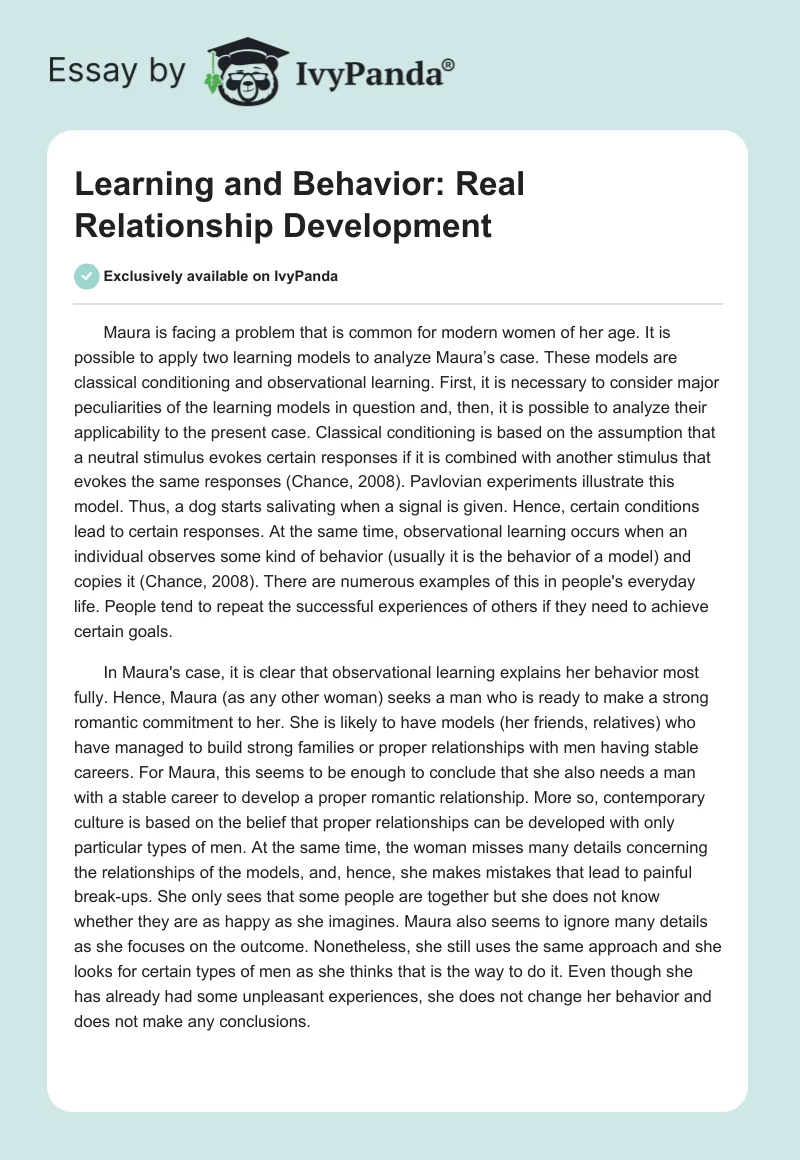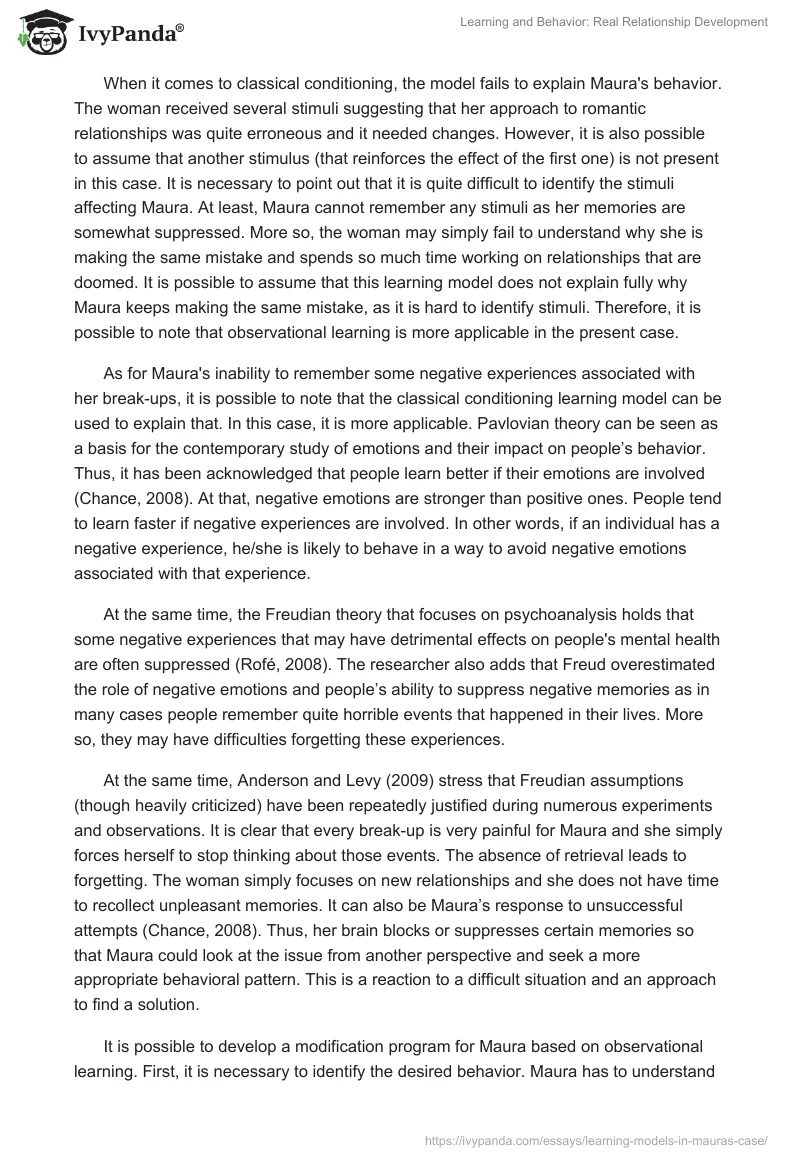Maura is facing a problem that is common for modern women of her age. It is possible to apply two learning models to analyze Maura’s case. These models are classical conditioning and observational learning. First, it is necessary to consider major peculiarities of the learning models in question and, then, it is possible to analyze their applicability to the present case. Classical conditioning is based on the assumption that a neutral stimulus evokes certain responses if it is combined with another stimulus that evokes the same responses (Chance, 2008). Pavlovian experiments illustrate this model. Thus, a dog starts salivating when a signal is given. Hence, certain conditions lead to certain responses. At the same time, observational learning occurs when an individual observes some kind of behavior (usually it is the behavior of a model) and copies it (Chance, 2008). There are numerous examples of this in people’s everyday life. People tend to repeat the successful experiences of others if they need to achieve certain goals.
In Maura’s case, it is clear that observational learning explains her behavior most fully. Hence, Maura (as any other woman) seeks a man who is ready to make a strong romantic commitment to her. She is likely to have models (her friends, relatives) who have managed to build strong families or proper relationships with men having stable careers. For Maura, this seems to be enough to conclude that she also needs a man with a stable career to develop a proper romantic relationship. More so, contemporary culture is based on the belief that proper relationships can be developed with only particular types of men. At the same time, the woman misses many details concerning the relationships of the models, and, hence, she makes mistakes that lead to painful break-ups. She only sees that some people are together but she does not know whether they are as happy as she imagines. Maura also seems to ignore many details as she focuses on the outcome. Nonetheless, she still uses the same approach and she looks for certain types of men as she thinks that is the way to do it. Even though she has already had some unpleasant experiences, she does not change her behavior and does not make any conclusions.
When it comes to classical conditioning, the model fails to explain Maura’s behavior. The woman received several stimuli suggesting that her approach to romantic relationships was quite erroneous and it needed changes. However, it is also possible to assume that another stimulus (that reinforces the effect of the first one) is not present in this case. It is necessary to point out that it is quite difficult to identify the stimuli affecting Maura. At least, Maura cannot remember any stimuli as her memories are somewhat suppressed. More so, the woman may simply fail to understand why she is making the same mistake and spends so much time working on relationships that are doomed. It is possible to assume that this learning model does not explain fully why Maura keeps making the same mistake, as it is hard to identify stimuli. Therefore, it is possible to note that observational learning is more applicable in the present case.
As for Maura’s inability to remember some negative experiences associated with her break-ups, it is possible to note that the classical conditioning learning model can be used to explain that. In this case, it is more applicable. Pavlovian theory can be seen as a basis for the contemporary study of emotions and their impact on people’s behavior. Thus, it has been acknowledged that people learn better if their emotions are involved (Chance, 2008). At that, negative emotions are stronger than positive ones. People tend to learn faster if negative experiences are involved. In other words, if an individual has a negative experience, he/she is likely to behave in a way to avoid negative emotions associated with that experience.
At the same time, the Freudian theory that focuses on psychoanalysis holds that some negative experiences that may have detrimental effects on people’s mental health are often suppressed (Rofé, 2008). The researcher also adds that Freud overestimated the role of negative emotions and people’s ability to suppress negative memories as in many cases people remember quite horrible events that happened in their lives. More so, they may have difficulties forgetting these experiences.
At the same time, Anderson and Levy (2009) stress that Freudian assumptions (though heavily criticized) have been repeatedly justified during numerous experiments and observations. It is clear that every break-up is very painful for Maura and she simply forces herself to stop thinking about those events. The absence of retrieval leads to forgetting. The woman simply focuses on new relationships and she does not have time to recollect unpleasant memories. It can also be Maura’s response to unsuccessful attempts (Chance, 2008). Thus, her brain blocks or suppresses certain memories so that Maura could look at the issue from another perspective and seek a more appropriate behavioral pattern. This is a reaction to a difficult situation and an approach to find a solution.
It is possible to develop a modification program for Maura based on observational learning. First, it is necessary to identify the desired behavior. Maura has to understand that relationships cannot be simply copied. She has to understand that the type of man she has in her mind is not necessarily the best option for her. She has to understand what proper relationships mean to her and how she can make sure that her partner can make a romantic commitment to her. She has to be able to terminate unsuccessful relationships when it is not too late and when the break-up will not be that painful.
When the goals are set, it is possible to develop the program. Maura has to share her views on ideal relationships by giving examples. This will help identify the models Maura has. If these are her relatives or friends, it is important to encourage Maura to talk to them about romantic relationships. Maura has to pay special attention to the following aspects: qualities of a man (career, background, features of character), the way they met, the way their relationship has been developing, and so on. It can be effective to encourage Maura to make a chart to identify whether these men have anything in common. If the model is a fictional character, the approach will be different. It is necessary to note that it is quite common. In this case, Maura should think of real-life examples rather than fictional characters. Her attention has to be drawn to the fact that reality is far from being TV images.
It is necessary to make Maura find various real-life examples and observe the way real relationships develop. If Maura does not have such examples, it is possible to encourage her to see documentaries concerning the life of certain people. Of course, it is important to choose a relationship that could be exemplary for Maura.
Based on these observations, Maura will develop major characteristics her partner will have. Of course, she will have to understand that the list created has to be very flexible as reality is far from being close to her anticipations. She will also have to develop an outline of proper romantic relationships. She has to understand that there are certain stages when she has to evaluate her relationships and terminate them if necessary. One of her problems is the waste of too much time. Finally, it can be a good idea for Maura to have a diary where she could write down her feelings and thoughts. It can be beneficial for her to read these diaries (especially the parts concerning break-ups). This will help her analyze her behavior.
It is necessary to add that some ethical considerations may arise when developing and implementing this modification program. First, this program implies that people will share their experiences. However, sometimes people may be reluctant to tell the whole truth about their relationships. There are chances that people, Maura will talk to, may idealize their partners and Maura may come to erroneous conclusions. It is also important to make sure that Maura develops an appropriate understanding of the nature of commitment and will be able to build a proper romantic relationship with men.
Reference List
Anderson, M.C., & Levy, B.J. (2009). Suppressing unwanted memories. Current Directions in Psychological Science, 18(4), 189-194.
Chance, P. (2008). Learning and behavior: Active learning edition. Belmont, CA: Cengage Learning.
Rofé, Y. (2008). Does repression exist? Memory, pathogenic, unconscious and clinical evidence. Review of General Psychology, 12(1), 63-85.


